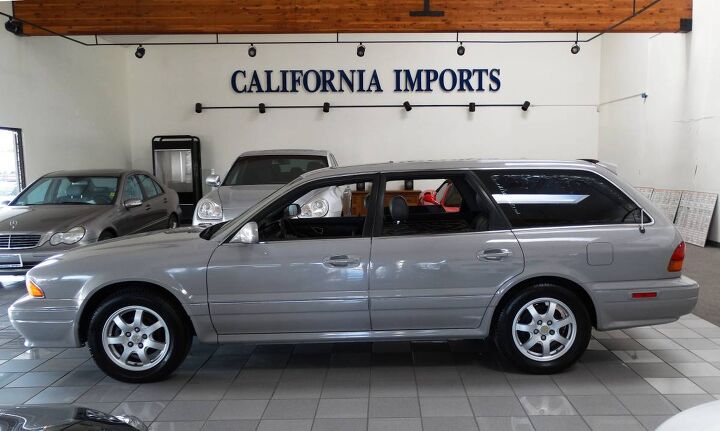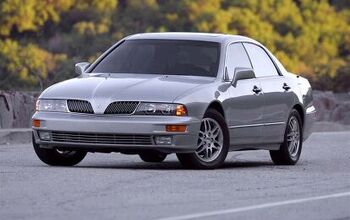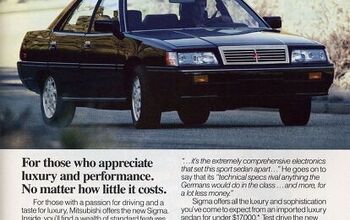Rare Rides: The Luxurious 1993 Mitsubishi Diamante Wagon

We featured the predecessor to Mitsubishi’s American flagship last year — a little Sigma sedan that happened to one of the cheapest Rare Rides ever shown. Today we take a look at the car that came after Sigma: the Diamante.
And it’s the rare wagon version.
Overlapping the end of the Sigma’s life were two distinct models serving as its replacement. On the lower end was the new Galant, which was roughly the same size as the Sigma. The new flagship for Mitsubishi in North America was the more expensive and luxurious Diamante, which was quite a bit larger than the car it replaced.
Mitsubishi needed to step up its offerings abroad after it being surprised by the introduction of the Acura Legend in 1986. The brand had no global car to compete with the Legend, nor anything from the upcoming Lexus and Infiniti brands. Enter Diamante.
There were three body styles, two of which were sold in North America. The most familiar version is the sporty frameless-window sedan (not a true hardtop), which was built in Japan. There was also a more traditional sedan with three windows on each side, a taller roof, and slightly altered front and rear clips. That version was for Europe and the Australian market. Australians called it Magna, and built it domestically. The Magna was used as basis for the North American Diamante wagon, which was designed and built by Mitsubishi of Australia.
The wagon followed the sedan version to North America a bit late. Sedans went on sale for the 1990 model year, but wagons didn’t show up until 1993. While the Japanese market Diamante had available all-wheel drive, all-wheel steering, world-first adaptive cruise control, and various engines and trims, North America received much more straightforward offerings.
There were two trims: base (later ES) or LS, and power was always to the front wheels via an automatic transmission. Base models had a standard 3.0-liter V6 that produced 175 horsepower, while upmarket LS versions had a dual-cam version of the same engine for 202 horses. Base models weren’t shy on equipment, but LS was required if buyers wanted alloy wheels, leather, or a sunroof.
A refresh took place a year after the wagons arrived, with new rear lamps on the sedan, satellite audio controls on the wheel, and a passenger airbag. Unfortunately for Mitsu, the refresh didn’t help move the Diamante. The rather expensive sedan and wagon were off the radar of most buyers. The wagon was dropped after 1995, as did all consumer sales. For ’96, the sedan was still available, though only to fleet customers. The relative product flop didn’t put Mitsubishi off, though, as a new Diamante arrived for 1997. Not that the second album went particularly well, either.
Today’s Diamante wagon is a 1993 example, and with all its equipment and leather trim is definitely an LS. With 134,000 miles, it looks nearly pristine and asks $2,995. It’s located in Orange County, which is slightly south of Downtown California.
H/t to commenter ciscokidinsf, who put today’s Rare Ride on Twitter.
[Images: seller]

Interested in lots of cars and their various historical contexts. Started writing articles for TTAC in late 2016, when my first posts were QOTDs. From there I started a few new series like Rare Rides, Buy/Drive/Burn, Abandoned History, and most recently Rare Rides Icons. Operating from a home base in Cincinnati, Ohio, a relative auto journalist dead zone. Many of my articles are prompted by something I'll see on social media that sparks my interest and causes me to research. Finding articles and information from the early days of the internet and beyond that covers the little details lost to time: trim packages, color and wheel choices, interior fabrics. Beyond those, I'm fascinated by automotive industry experiments, both failures and successes. Lately I've taken an interest in AI, and generating "what if" type images for car models long dead. Reincarnating a modern Toyota Paseo, Lincoln Mark IX, or Isuzu Trooper through a text prompt is fun. Fun to post them on Twitter too, and watch people overreact. To that end, the social media I use most is Twitter, @CoreyLewis86. I also contribute pieces for Forbes Wheels and Forbes Home.
More by Corey Lewis
Latest Car Reviews
Read moreLatest Product Reviews
Read moreRecent Comments
- ToolGuy I watched the video. Not sure those are real people.
- ToolGuy "This car does mean a lot to me, so I care more about it going to a good home than I do about the final sale price."• This is exactly what my new vehicle dealership says.
- Redapple2 4 Keys to a Safe, Modern, Prosperous Society1 Cheap Energy2 Meritocracy. The best person gets the job. Regardless.3 Free Speech. Fair and strong press.4 Law and Order. Do a crime. Get punished.One large group is damaging the above 4. The other party holds them as key. You are Iran or Zimbabwe without them.
- Alan Where's Earnest? TX? NM? AR? Must be a new Tesla plant the Earnest plant.
- Alan Change will occur and a sloppy transition to a more environmentally friendly society will occur. There will be plenty of screaming and kicking in the process.I don't know why certain individuals keep on touting that what is put forward will occur. It's all talk and BS, but the transition will occur eventually.This conversation is no different to union demands, does the union always get what they want, or a portion of their demands? Green ideas will be put forward to discuss and debate and an outcome will be had.Hydrogen is the only logical form of renewable energy to power transport in the future. Why? Like oil the materials to manufacture batteries is limited.







































Comments
Join the conversation
Beautiful car. I always liked them because of design being more elegant than Toyota/Honda/Nissan/Mazda. Used ones were pretty cheap in Germany compared with German cars. Still do not understand why they were not popular in US. It's the car made for American tastes.
What a nice car and what a shock at how far Mitsubishi has fallen. Now they build a cheap rollerskate and a bunch of bland me too suv's that aren't compelling.